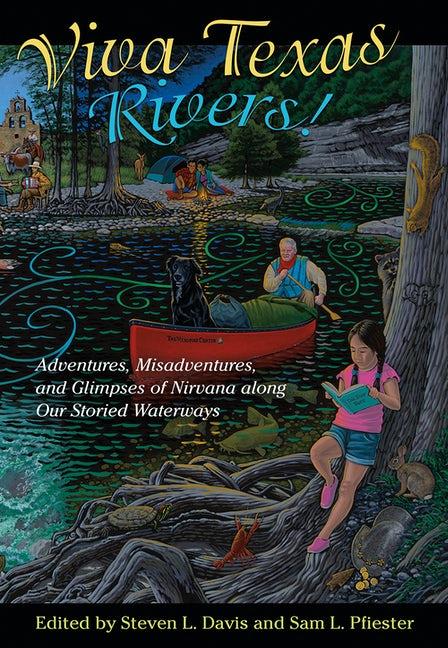
ANTHOLOGY
Viva Texas Rivers!: Adventures, Misadventures, and Glimpses of Nirvana along Our Storied Waterways
Edited by Steven L. Davis and Sam L. Pfiester
Texas A&M University Press
Hardcover, 978-1623499808, 256 pages
November 15, 2021
Texas has more than 250 rivers, and each is a water resource now under threat from climate change, development, farming and ranching, and the growing thirst of a rapidly expanding state population.
Viva Texas Rivers! celebrates the Lone Star State’s riverine waterways with an excellent and timely selection of essays, poems, and excerpts from books and short stories that have ties to specific streams. And the book unabashedly draws its inspiration from Texas writer John Graves’s classic 1960 personal narrative, Goodbye to a River. Graves took a 150-mile “farewell” canoe trip down the Brazos River at a time when it appeared the historic waterway might be destroyed by a series of thirteen planned flood control dams. In the wake of his book’s publication and its public strong reception, only a few of the dams were built, and the Brazos continues to flow.
The editors of this new anthology, Stephen L. Davis and Sam L. Pfiester, note that “Goodbye to a River did more than help spark environmental awareness in Texas. It also inspired a new kind of writing, creating a bond between rivers and writers that has flowed ever since. Since Graves’s day, many more authors have brought to life ‘the spirit of place’ for dozens of Texas rivers and streams, highlighting the distinctive qualities that make each waterway special. Our aim in Viva Texas Rivers! is to gather the best of these works into a single volume.”
Some of this collection’s works previously have appeared in other publications and formats. But several new essays and other works also are presented. The writers represented range from Gary Cartwright, Jan Reid, Elmer Kelton, and Elroy Bode to Bill Minutaglio, Stephen Harrigan, Larry McMurtry, and Naomi Shihab Nye, plus numerous others. Joe Holley, for example, reflects on the Texas Panhandle’s only river. “The Canadian,” he writes, “is no warbling, spring-fed stream like the Comal or the San Marcos. Sluggish and slow for much of its quicksand-pocked course, occasionally disappearing altogether, it bears no resemblance to the mighty Colorado or the wide Missouri. I call it a workaday river, a resource to be used and enjoyed, if not necessarily appreciated.”
The rivers highlighted in this book are grouped by major geographic region: North, East, South, and West Texas. And the waterways are illustrated in maps by Austin artist and mapmaker Molly O’Halloran.
The editors of Viva Texas Rivers! likewise bring noteworthy credentials to their book. Stephen L. Davis is the literary curator of the Wittliff Collections at Texas State University in San Marcos, and author and editor of eight books. Sam L. Pfiester is chair of the Wittliff Collections advisory council and author of four novels, as well as a produced screenplay.
Despite the Texas rivers’ visual appeal and environmental and historical importance, they face new troubles ahead. Viva Texas Rivers! includes an appendix listing Texas river advocacy groups. And in a sobering afterword subtitled “The State of Texas Rivers Today,” one of the Lone Star State’s leading conservationists, Andrew Sansom, sounds an urgent alarm. “According to the Texas Water Plan,” he writes, “the population of Texas is expected to more than double between 2000 and 2060, growing from 21 million to 46 million. Although we are faced with the enormous task of proving life-giving water to all these new Texans, we have already given permission for more water to be withdrawn from many of our rivers than is actually in them.”
In short, unless we take action soon, we may be saying goodbye to several rivers.
Some of the essays, poems, and book excerpts in Viva Texas Rivers! are short and sharply focused. But, in other essays and excerpts, the authors offer image-rich scenery as they float along with the waters’ flow. This is an easy book to enjoy, no matter if you are a straight-through reader or one who likes to pick and choose from a table of contents depending on your mood, geographic interests, or available free time.
STEVEN L. DAVIS is the literary curator of the Wittliff Collections at Texas State University. The author and editor of eight books, his literary honors include the PEN Center Award for Research Nonfiction. He is a past president of the Texas Institute of Letters.
SAM L. PFIESTER is chair of the Wittliff Collections advisory council and is the author of four novels: The Perfect War, The Golden Lane, Solomon’s Temple, and Salt Creek. He is also the producer and screenwriter of the 2018 movie Blanche.
